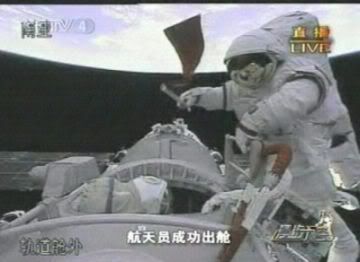
First Chinese "Taikonaut" Spacewalk, September 2008. photobucket/emperoryu
In a recent appearance on The Daily Show, Neil deGrasse Tyson, Director of the Hayden Planetarium in New York City and researcher at the American Museum of Natural History, offered an impassioned defense of the American space program. He argued that American public policy after the 1960s “no longer advanced a space frontier” – and no longer reaped the innumerable unintended technological and scientific advancements of space travel research. Ideally, policy makers would recognize the intrinsic value of inspiring young Americans to pursue scientific educations, but Tyson adds that these fields “are the foundations of tomorrow’s economies, and without it America will be ill-equipped to compete internationally. If China wants to put a military base on the moon, we’re there in ten years.” –Neil deGrasse Tyson, The Daily Show (2/29/2012)
Tyson’s sober article in the March issue of Foreign Affairs magazine, titled, “The Case for Space”, belies his optimistic interview. He writes that “only three motivations have led societies to spend… capital on ambitious, speculative projects: the celebration of a divine or royal power, the search for profit, and war.” In the American case it seems that war, or fear of war, has been the major motivator. The militaristic origins of America’s space program are undeniable. The space program was largely established in response to the Soviet Union’s launch of Sputnik 1, which consisted of firing a hollowed ballistic missile head in to orbit. The implications were obvious to American policy makers and NASA was founded to counter the Soviet Union’s early advantage.
Tyson cites a Chinese policy paper that describes the country’s ambitious five-year plan to develop its own space program, adding, “the country has an excellent track record of matching promises with achievements.” President Obama never cited Chinese progress in this area as a concern, but there are broader fears about its military. Tyson is cautiously optimistic that fears of a narrowing military advantage over China might produce another “Sputnik moment” for America, spurring a resurgence in national interest and funding for space travel research and development.
“This is our generation’s Sputnik moment.” -President Barack Obama, State of the Union Address (1/25/2011)
In his 2011 State of the Union Address President Obama endorsed the view that American superiority in space was the result of Cold War competition and that “after investing in better research and education…we unleashed a wave innovation.” Unlike the 1950s, the United States does not have a single global competitor, but is instead faced with disparate groups and organizations. Iran seems like an obvious contemporary substitute for the Soviet Union – there are fears of a “cold war” developing over the nuclear standoff – but the White House National Defense Strategy reflects a greater focus on Chinese rapid technological advances. Perhaps, that is the inspiration for Obama’s assertion that in order to “strengthen our security, protect our planet, and create countless new jobs for our people” Americans must replicate the levels of research and development achieved at the height of the “space race.”
Perhaps President Obama should have mentioned Chinese advancements. Ideally, support for the space program would be for purely scientific and educational purposes, but fear – in this case, fear of diminishing military advantage over China – will likely be more effective in reigniting interest in the space program. The returns on these investments, intended and unintended, will be critical in the technologically driven economies of the twenty-first century. Whether driven by ego, profit or fear, America should consider the importance of a serious investment in our space program because of the increasingly technologically driven international economy. Perhaps, some domestic programs would suffer from a heightened investment in space exploration, but the space program should be considered one of the critical domestic programs that deserves additional federal funding.
Thanks for introducing this subject. You open with a small error, however: the Hayden Planetarium (as clearly indicated in your link) is in New York City (Manhattan), not Washington, DC. Also your photo is intriguing but too small to make out exactly; we don’t know what those strange figures are. And I assume that “Taikonauts” are the Chinese term for astronauts, but you never tell us.